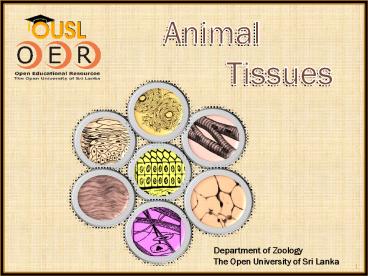Animal Tissues - PowerPoint PPT Presentation
1 / 29
Title:
Animal Tissues
Description:
explain how the cells of this tissue type enable . ... and smooth . muscle tissues in terms of location, structure, and function. ... Nucleus of. schwann. cell ... – PowerPoint PPT presentation
Number of Views:567
Avg rating:3.0/5.0
Title: Animal Tissues
1
Animal Tissues
Department of Zoology The Open University of Sri
Lanka
2
- Content
- Learning Outcomes
- Introduction
- Epithelial tissues
- Connective tissue
- Muscular Tissue
- Nervous Tissue
- Classification of tissues
3
Learning Outcomes
- By the end of this session you should be able to
- list the major functions of each of the four
major animal - tissue types
- give the functions carried out by epithelial
tissue types - and state their general location/s
- describe the basic features of connective
tissue, and - explain how the cells of this tissue type
enable - connective tissue to carry out its various
tasks. - distinguish among skeletal, cardiac, and smooth
- muscle tissues in terms of location,
structure, and function
4
Introduction
- Multicellular (large) organisms function more
- efficiently if cells become specialized for
specific - functions.
- A tissue is composed of cells that function
together in a - specialized activity.
5
Introduction
- There are four types of tissues found in
- an animal.
- 1. Epithelial tissue
- 2. Connective tissue
- 3. Muscle tissue
- 4. Nervous tissue
6
- 1. Epithelial tissue
- Forming tight covering and protecting
layers below - 2. Connective tissue
- Holding other tissues
- together and are surrounded by
- lots of nonliving material.
7
- 3. Muscle tissue
- Shortening and lengthening to
- move other tissues.
- 4. Nervous tissue
- Allowing rapid flow of ions
- in and out to conduct
- signals
8
1.Epithelial tissues
- Two types of epithelial tissues
- 1. Covering and lining epithelium ( outer
layer of the - skin and some organs)
- 2. Glandular epithelium
- ( constitute the secreting portion of
glands)
9
Epithelial tissues
- There are three types of cells in epithelial
tissues - Squamous thin flat cells
- Cuboidal cells are roughly square
- 3.Columnar - elongated cells.
10
Epithelial tissues
- Three types of cell layers exist in epithelium
tissues
11
Glandular epithelium
- Glands are made up of single or a mass of
epithelial - cells.
- Two types of glands
- 1. Exocrine - Secrete their products in to
ducts - Eg . Salivary glands and mammary glands
- 2. Endocrine - Secrete their
products into blood - stream
- Eg. Pancreas
12
Glandular epithelium
- Exocrine glands
-
-
Endocrine glands
13
- Functions of epithelial tissues
- Provides physical protection
- Controls permeability
- Detects sensations (sight, smell , taste,
equilibrium)
14
- 2. Connective tissue
- Most abundant and most widely distributed
tissue in the body. - These tissues provide support for organs and the
- body as a whole, protect and insulate
internal - organs and compartmentalize structures such
as - skeletal muscles, nerves.
15
Connective tissue
- Connective tissue is made up of cells, ground
- substances and fibers. Ground substances
together - with fibers make matrix.
16
Connective tissue
- Connective tissues can be classified as
- Loose connective tissue (fibers are loosely
woven) - B. Dense connective tissue
- (few cells among a dense network of fibers
with - little ground substances)
- C. Cartilage (tough but flexible)
17
Connective tissue
Blood tissue - (composed of blood cells, cell
fragments and blood plasma)
18
Connective tissue
D. Bone tissue (two types compact and
spongy) compact with osteons spongy -
no osteons
19
- 3.Muscular Tissue
- Muscle cells are elongated and are called as
muscle fibers - These cells have main properties
- Excitability ( ability to respond to stimuli)
20
Muscular Tissue
- Contractibility (ability to contract)
- Extensibility (ability to be stretched without
tearing) - Elasticity (ability to return to its normal
shape)
21
Muscular Tissue
- Muscle tissue is classified into three types
- (Cardiac, Skeletal and Smooth)
22
Muscular Tissue
- Skeletal muscles are known as striated muscles or
voluntary muscles. - These muscles are attached to bones by tendons
and are responsible for skeletal movements. Basic
unit of a skeletal muscle is a muscle fiber.
23
Muscular Tissue
- Cardiac muscle is unique and found only in
- the wall of the heart.
- Its fibers have cross striations .
- This muscle is involuntary.
Cardiac muscle
24
Muscular Tissue
- Smooth muscle tissue is made up of thin
elongated - muscle cells called smooth muscle fibers.
- These fibers are pointed at their ends and each
has a - single , large oval nucleus.
- Each cell has many myofibrils which lie parallel
to - one another in striated pattern , as in
skeletal muscles.
25
- Nervous Tissue
- Nervous tissue is found in the brain , spinal
cord and - nerves and consists of only two principal
kinds of cells , - neurons and neuroglia.
26
Nervous Tissue
- Cells of nervous tissue have three principal
parts - Dendrites
- Cell body
- Axon
27
Nervous Tissue
- Neuroglial cells that do not transmit impulses
but - instead support the activities of the
neurons . - Schwann cells, a type in the peripheral nervous
- system only in mammals.
28
Tendon Ligament
Striated
Squamous
Areolar
Cuboidal
Smooth
Adipose
Columnar
Cardiac
Bone Cartilage
Cilliated
Skeletal
Glandular
Fluid
Blood
Lymph
29
Author- Mrs. W.A.Y. Chandrani Web Content
Developer Chameera Kendaragama
Produced by The Open University of Sri Lanka
2014































